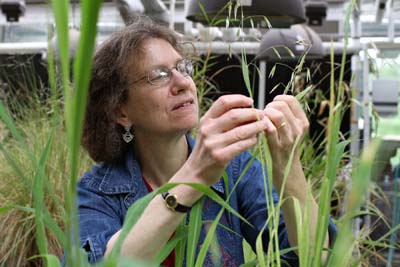
Elizabeth Kellogg, the E. Desmond Lee Professor of Botanical Studies, is one of five researchers proposing a global census of the genes of all flowering plants. Scientists believe the final total could be somewhere between 400,000 and 500,000 species.
Botanist Elizabeth Kellogg has a stack of plant parts sitting next to her desk. They’re dried and pressed between sheets of paper and heavy books. The plants are identified by what they look like, a process that’s been around for hundreds of years. Kellogg would like to see the science of identifying plants move into the 21st century where it will impact the world’s food supply and the primary sources of drugs and drug leads.
Kellogg, the E. Desmond Lee Endowed Professor of Botanical Studies at the University of Missouri–St. Louis, is one of five researchers proposing a global census of the genes of all flowering plants. Recent advances in technology and the ever-decreasing cost of sequencing DNA make the genomic census of the plants and their value something to consider.
“It’s an idea whose time has come,” Kellogg said. “We are faced with the issue of extinction of thousands of species of plants each year (largely because of the impact of human activities). And we are beginning to understand the importance of an accounting of existing and as yet unknown plant biodiversity.”
According to their paper, “The Genomes of All Angiosperms: A Call for a Coordinated Global Census,” the scientists state that all flowering plants (angiosperms) are believed to comprise somewhere around 360,000 species. An exact count of the plants is impossible because of the many plants on the globe yet to be discovered.
If these were all found, a final total of somewhere between 400,000 and 500,000 species seems likely, they conclude.
That accounting seems like an enormous job, but the technology to make it happen is now cheaper and more accurate than ever before.
“Technology is moving so fast that it’s now possible to look at the entire DNA of an organism, which is something we couldn’t do just five years ago, ” she said.
Being able to look at what she calls “snippets” of DNA she can ask, “Does this thing have the genes to make chemicals for pharmaceuticals or can it improve our crop plants?”
Presently, a relatively few plants provide the earth’s population with food and medicine. Of the 2,500 crop species, 103 supply over 90 percent of the calories for human consumption.
“And most people only want to eat three of them –wheat, rice and maize,” Kellogg said.
But the value of those three grasses is enormous – think wheat, which takes up the most land, rice which feeds the most people and maize which has the greatest market value.
“By studying the DNA of those grasses and comparing it to their wild relatives, we can match similar characteristics and differences,” she said.
The same holds true for modern medicine where plants are the primary source of drugs such as digitalis, morphine and aspirin. The loss of known plant species or the thousands of species as yet unfound will have a significant impact on the future of our planet.
The scientists working with Kellogg: David Galbraith, School of Plant Sciences and Bio5 Institute, The University of Arizona (Tucson); Jeffrey Bennetzen, Department of Genetics, University of Georgia (Athens); J. Chris Pires, Division of Biological Sciences, University of Missouri–Columbia and Pamela Soltis, Florida Museum of Natural History and The Genetics Institute, University of Florida (Gainesville), initially hope to establish a network of like-minded scientists.
They have laid out plans for annual conferences, a website, exchange visits, white papers and coordinated searches for funding. Their first, a grant from the National Science Foundation, was turned down, not uncommon for the NSF in recent years, according to Kellogg. They are planning another application.
The data currently being gathered from DNA sequencing around the country holds promise. Kellogg has worked with the Joint Genome Institute run by the U.S. Department of Energy in Walnut Creek, Calif. to decipher the genome of foxtail millet ad minor grain and useful model for crops for biofuels. A large genome sequencing facility in Beijing, China is working on rice and many other plants. Closer to home, Washington University in St. Louis has conducted genome sequencing of maize.
Kellogg and her colleagues conclude that although the scale of DNA sequence information “dwarfs any previous type of biological information gathering,” it is only a tiny portion of what can be done. They understand that “with 500,000 species, full genome sequence analysis of all angiosperms is not on the near-term horizon.”
Kellogg returns to the specter of famine in our world, the focus of much of her life’s work.
“A lot of people are thinking very hard on how to combat it,” Kellogg said. “If we could find a drought-tolerant plant by cranking up one gene, think of the number of people we could feed.”














